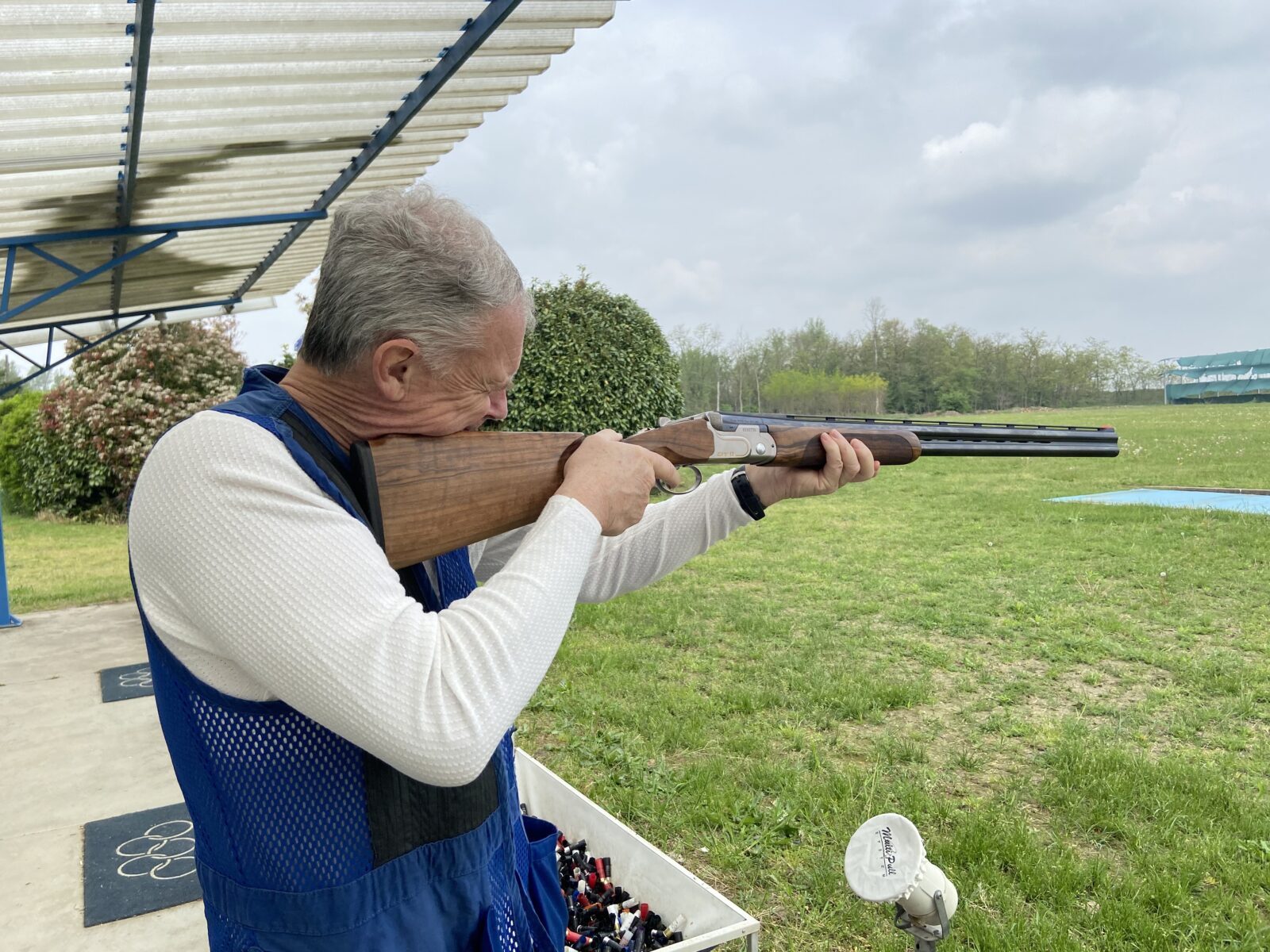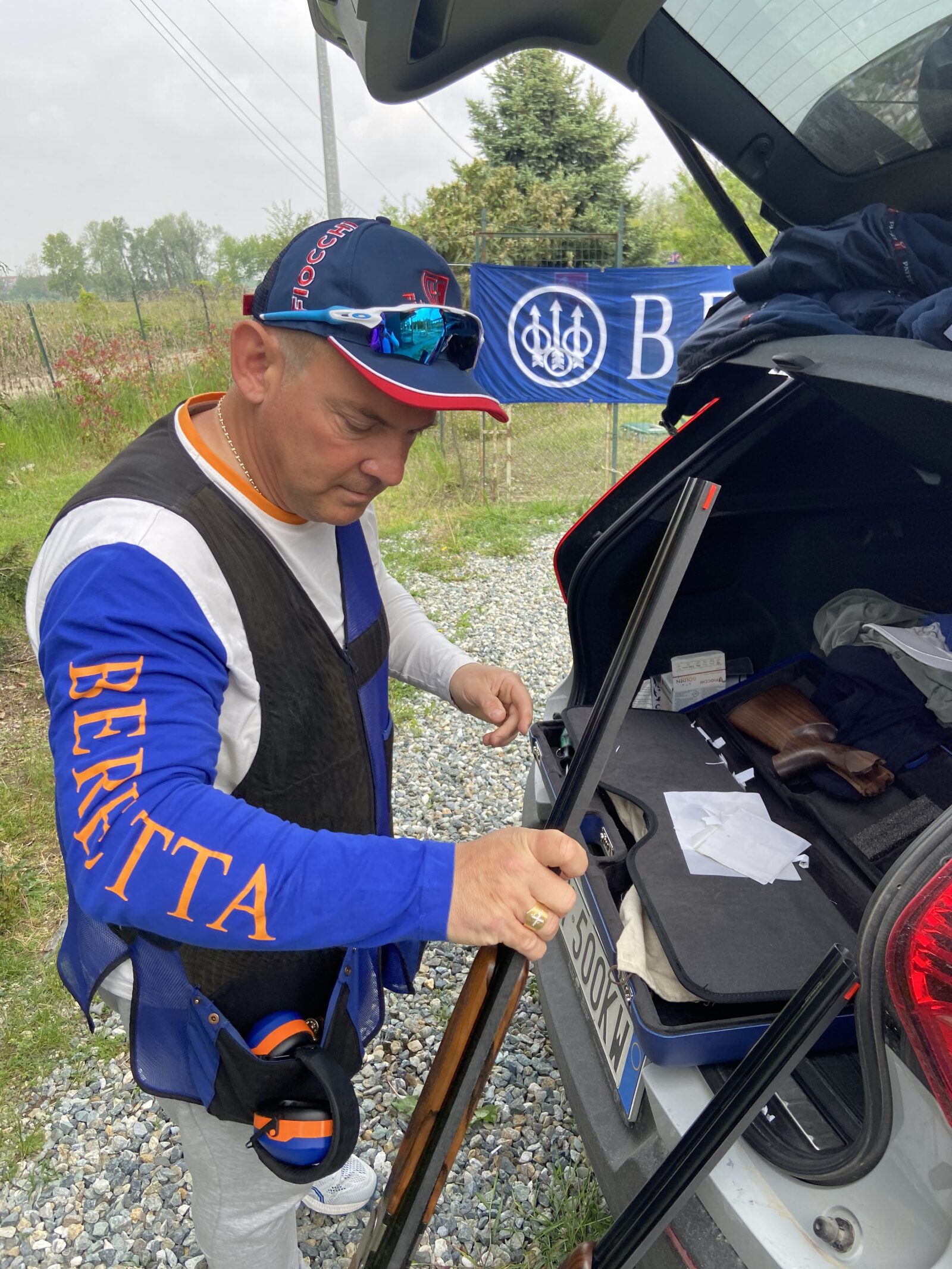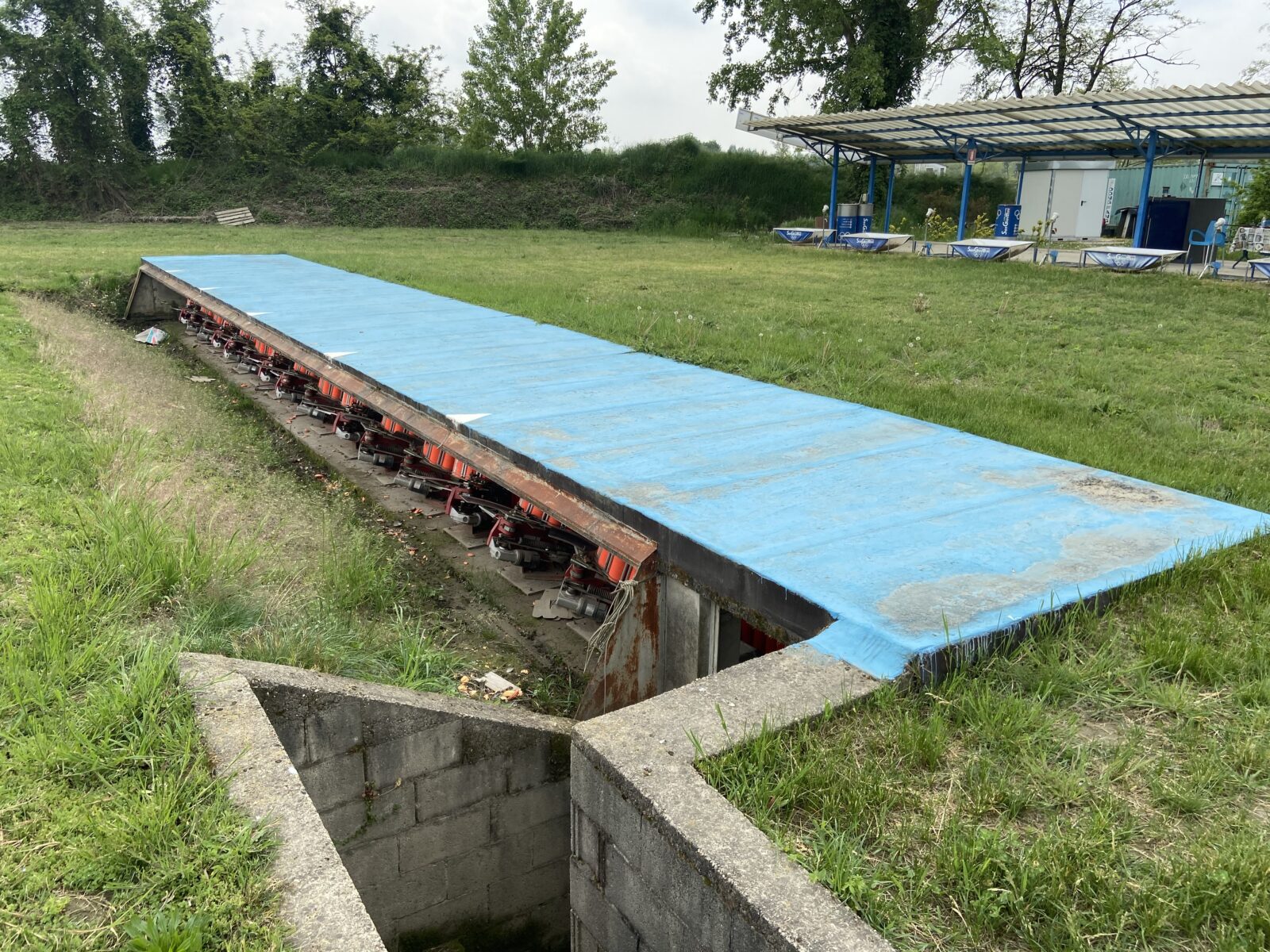Trapshooting with The Shooter of God

New respect for a sport and one of Italy’s most decorated Olympians
VERCELLI, Italy — I managed to live 65 years without ever holding a gun, let alone shoot one or shoot someone. I can’t imagine shooting anyone. It would be too hard. But what I was about to do was much harder.
Shooting a clay sphere four inches in diameter whizzing 75 mph across an open field.
Placing a shotgun in my arms was one of the most accurate shooters in history. Giovanni “Johnny” Pellielo has won four Olympic medals, four World Championships and four European Championships. He is going for his eighth Olympic team — at age 51. He is to world trapshooting what Andrea Bocelli is to world singing.
The New York Times sent me to this small city in Northern Italy to profile him in a story it published Sunday. Of all the athletes I’ve interviewed — and after trying trapshooting I know these guys definitely have athletic ability — he’s one of the most fascinating. Pope John Paul II personally advised Johnny, deeply religious since he was 7, that he could pursue careers in shooting and faith. So he went off and became an ordained bishop with the independent Holy Celtic Church and became an international shooting star.

During a pilgrimage to Lourdes, France, a small boy told him without prompting to “go build your church.” Known as “The Shooter of God,” Johnny returned home and converted a first-floor room in the house he shares with his mother into a chapel, complete with kneeling board for prayer, an altar and religious statues. He has bishop vestments he wears when he or a visiting priest gives mass.
He had life-threatening asthma as an infant, wore an oxygen mask until he was 10 and was on medication until he was 17. He is even cross-eyed which does not behoove one to shoot 4-inch objects flying 75 mph across an open field.
He’s a saint of a guy. Personable. Funny. Insightful. Modest. Totally non-judgmental. He gave me tons of time. I talked to him in the office of the shooting range that bears his name, filled with photos of him from around the world, various medals around his neck. He gave me a tour of his home chapel. We dined at Christian & Manuel, a spectacular Michelin star restaurant where I had the best risotto of my life which I’ll blog about next week.

He still lives in his hometown of Vercelli, a pleasant tree-lined town of 41,000 halfway between Milan and Turin. Vercelli is the rice capital of Europe and its Po River valley produces more rice — 1.5 million tons — than anywhere else. As my train came in from Milan, the outskirts of Vercelli were swamped with rice patties.
Trapshooting difficulties
I’ve covered so many sports in my 40-year sports writing career which included six Olympics. Shooting was not one of them. I had to see him do it. On videos I studied during my research, it looked impossible, on the level of pole vaulting and landing a quad in figure skating. He’d say “Pull.” (Yes, they really say that.) Suddenly a dot I could barely see would fly across the sky. He’d pull the trigger and suddenly the dot becomes a puff of smoke.
“How do you DO this?” I asked him.
He smiled modestly and took me to one of the three shooting ranges at the San Giovanni Shooting Campo Vercelli. I was about to find out. He opened a cabinet and inserted his pre-paid card to start his training session.
He took the shotgun, 12 gauge with a 30-inch barrel and custom-made stock made by Beretta, the Italian company that’s the world’s top trapshooting shotgun in the world. He stood on a big blue mat with the Olympic rings with a short wall in front of him. He said “Pull” and the voice-activated trap launched the clay target from one of 15 ground-level machines from a hidden bunker about 40 feet in front of us.

The targets flew left to right, right to left and away from him. The quickness required is underrated. The hand-eye coordination is astonishing.
I stood back and watched him turn target after target into pixie dust. This is nothing. At a World Cup competition in Cyprus in 1999, he set the world record with 125 out of 125. He matched it in 2013 as have numerous others since. He won the bronze medal at the 2000 Sydney Games and silver in Athens, Beijing and Rio. He lost gold in Rio on the fourth playoff shot.
“Aren’t you cross-eyed?” I asked.
“Actually my eyes are a bit independent,” he said in Italian. “It’s an advantage, actually. I can take the rifle barrel a little bit higher and with the other eye I can look at the trap in advance.”
Many shooters don’t look terribly fit. Johnny is and not just for 51. He has a short, compact body, with short-cropped hair with little gray. His round, cherubic face has nary a line on it. He doesn’t drink or smoke. He never married. Clean living has been good to him.
What separates him from most in the world, and the young shooters who fell off the world radar long ago, is what’s inside. His inner faith has only enhanced his drive.
“This has always been my philosophy,” he said. “I’m 51 and it has been 30 years since I’ve been doing Olympics. I’ve done seven Olympic Games. In total, 28 years and in my life I always confronted a generation of new sportsmen, difficulties and the pandemic. I believe that what is important, what really matters, is to have inside ourselves enthusiasm of the desire.”
History
Trapshooting goes back to the late 18th century when real birds were used. Birds were placed under “traps” then released. Even before SPCA, the sport had decided a field covered in dead birds was not good optics, not to mention a little gross. They replaced them with artificial birds and glass balls before going to round, clay targets, similar to what’s used today.
Trapshooting has been in the Olympics since the 1900 Games in Paris and more than 100 countries take part at the international level. In few countries is trapshooting more popular than in Italy which has won more Olympic trapshooting and skeet shooting medals than any country and where there are 24,000 registered shooters. The U.S. is second but one of the world’s best-known trapshooters never made the U.S. Olympic team.
Annie Oakley.
I am no Annie Oakley. I’m more like Andrea Bocelli and I can’t sing. Four years ago I developed a disease in my optic nerve and went blind in my right eye. Johnny handed me a shotgun and inserted cartridge ammunition the size of Vienna sausages.
What could go wrong?
In the latest of a long line of really stupid questions I’ve asked in my career (I once asked my hotel clerk in Belgium where’s a good place to get a Belgian waffle and she said “Belgium.”), I asked if these ammo can kill people. Showing his deep faith precludes calling a reporter an absolute moron, he merely smiled and said, “Yes, they can.”
How I scored
I stood on the mat with the shotgun butt against my shoulder. I was going to aim first. I didn’t want to raise the shotgun in a split second and shoot some passing car. I said “Pull” and the voice-activated trap sent a small reddish-orange sphere hurling into the sky like a line drive to the outfield and I’m the catcher. It was about 120 feet away when I pulled the trigger.

Of course, I hit nothing. I listened for broken glass. The butt of the shotgun shot backward into my shoulder.
Johnny came over, pulled a level and the shotgun bent in half. I inserted another cartridge from the pocket of the bulky vest all shooters wear and tried again. I followed the trap racing across the sky with my barrel, my eye in the site and pulled.
Nothing.
Again, I asked, this time exasperated, “How do you do this?”
It felt futile. I experienced this level of frustration playing golf. However, it’s a lot easier to throw a pitching wedge than a shotgun, not to mention a tad less dangerous.
I shot four or five times with no success and saw his record of 125 of 125 in new light, the kind reserved for divine intervention or parting of the Red Sea.
But then something happened. I shot and the target exploded. It made a clicking sound and orange dust filled the air in front of me. I felt as if I’d shot a hole-in-one. I kept shooting and hit a couple more. Now it felt like these big cartidges had a honing device. I kept the barrel in the general direction and kept it high.
I finished my 25 shots. I’d hit five.
“Very good,” he said. “Many people hit zero or one maybe. But you’re an American. You’re a natural.”
The gun debate
Ha! America’s reputation for guns is worldwide and well-deserved. The comment wasn’t a dig. It was a compliment accompanied by a wry smile. On my best professional behavior, I didn’t come to Vercelli to engage in a gun rights debate with one of the best shooters in the world with a rifle in his hand.
I was in no position to argue. However, I wanted to know what this pious, peaceful man who never raises his voice thinks about the U.S. and its continuous gun debate. I’ve weighed in here before. The only comment I’ll make is a statement in fact.
According to the United Nations Office on Drugs and Crime, in the last year of data collected, the U.S. had nearly twice the annual gun homicides, 16,218 in 2018, than all of Europe’s 9,463 outside Russia’s 11,964. Europe’s population outside Russia is nearly twice that of the U.S. Italy, where you can buy handguns but the laws are much more restricted, had only 345 homicides by guns in ‘18. Rome, where I live along with 2.8 million people, averages only 28 homicides a year, hardly any by guns. Sixteen U.S. states allow guns to be carried in public.
I asked him what he thinks of the U.S. homicides by guns.
“The problem isn’t the guns,” he said. “The problem is education. The real problem of all these accidents is a disadvantaged situation. There is a lack of education. We have to reach families. What happened is it’s just not a kids’ game. This is the consequence of a big social disadvantage. Those kids, if they don’t kill with a weapon, they take an ax and kill. If they don’t have a gun they take something else.
“The problem is not the gun itself.”
I told him Americans can go into supermarkets and buy guns.
“Why not?” he said. “The problem is intelligence. For example, look at how many women in Italy are killed with acid. People are killed with clubs. What are we going to do? Not make any more acid or bats?”
I said guns are made to kill. Acid and bats are not.
“No. Guns are not to kill,” he said. “Guns were not invented to kill people but to protect. Why is the United States so strong? Because they have the strongest defense system. Why do Tibetan monks get beaten by Beijing? Because they have no weapons. They can’t protect themselves. Weapons could insure protection to a state. I’m not against weapons. Weapons are conceived for protection. Weapons are a deterrent.”
Guns vs. religion
I shifted gears to a less controversial topic: religion, believe it or not. Playing the devil’s advocate, I asked how he balances his faith with shooting a gun.
“I’m proud to do a sport where you use a weapon,” he said. “Why? Because all the people in Italy who do this sport, none of them use the weapon against another person. Here in Italy there (was) an insurance for sportsmen called Sportass. Shooting was at the lowest level of accidents. Soccer was first; shooting last. This is a big honor.
“I’m extremely happy that in 30 years of my career I’ve trained many kids and adults who started this sport. I’ve never had one single person who used the rifle to hurt another person.”
Johnny finds out after the European Championships next Monday through June 3 in Osijek, Croatia, if he’s chosen for Italy’s lone men’s trapshooting spot in the Olympics. He won’t go to Croatia. He’ll train through Europeans. His federation making the decision knows what he can do.
I will watch shooting at the Olympics with all new respect for these remarkable Olympians, marveling at their puffs of smoke.


May 25, 2021 @ 8:19 am
I had read The NY Times article this weekend without paying attention to the byline. Congratulations on your profile.
I did want to bring up the “bishop” angle and how I was really confused by that. As a Catholic, I would assume that a bishop in Italy means a Roman Catholic bishop. It only is later that you cite the sect that gave him the title and it is not a mainstream one.
Also, having a home “church” is not common. Did he want to be ordained? Does he preside at Mass at his “church”? Why cite his interactions with a Catholic Pope if he has gone and joined another sect and has accepted the title of bishop in that sect? Does he still consider himself Catholic?
Your article raised all these questions and it made me think that neither you nor anyone at the Times had enough awareness to dive into these issues. Maybe that’s not a fair criticism and maybe parts got cut, but to put in a “bishop” angle and then not address the real questions it raises seems odd.
I can’t question another person’s faith, but it just rings really weird the way he is portrayed. A church is a communal space consecrated to worship for the community. A priest or bishop has a role within that physical space and within the community, neither of which is a personal role. Priests and bishops are ordained for service to a community. There is no mention in your article of the community. Is he just cosplaying a role?
Maybe it would be helpful to have someone with a religious background read these before publishing.
May 27, 2021 @ 1:10 pm
The Celtic Christianity connection is interesting, some of the first churches were originally private Roman villas – Christianity going back to its roots. Will have to look out for the paddy fields when next taking the train through Italy. Enjoyed this article, thank you!
June 29, 2021 @ 3:55 pm
Seems like Mr Pellielo’s logical philosophy is ‘Guns don’t kill people, people kill people’. His view is to address inappropriate engagement of weapons, and rightly infers that guns are a healthy deterrent to their inappropriate use. Thanks for sharing this insight from Italy.
March 9, 2022 @ 6:21 pm
Is Johnny still blind in his right eye? Does he have a special stock that accommodates a right handed person shooting with only his left eye?